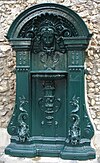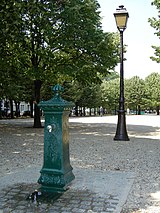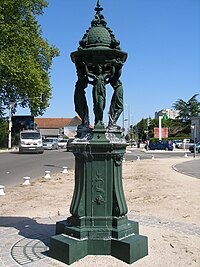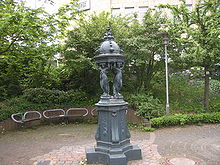Wallace fountain
The Wallace fountains are public drinking water dispensers in the form of small cast iron sculptures that are set up in various locations around the world. Most are on pedestrian walkways throughout the Paris metropolitan area , where they were first built. They are named after Richard Wallace , an Englishman who financed their construction. Because of their outstanding aesthetics, they are considered a Parisian specialty worldwide .
background
Paris went through a difficult time during the Franco-Prussian War in 1870. The major upheavals of these days included the re-establishment of the republic , the short-lived Paris Commune , the destructive Prussian bombings and, finally, the painful military defeat associated with the loss of Alsace-Lorraine .
Despite the great devastation, the city was rebuilt very quickly. After less than ten years it showed a new face with new buildings such as the Opéra Garnier and new boulevards such as Raspail or Saint-Germain. In addition, patronage became fashionable: wealthy citizens financed numerous “good works” (such as the French Red Cross or the Salvation Army ) in order to maintain their good reputation.
Sir Richard Wallace
One of the most outstanding and at the same time most reserved patrons was Sir Richard Wallace. After inheriting a large fortune from his father in August 1870, he decided to distribute it to all Parisians, which earned him great popularity. In contrast to other members of the upper class, for whom charitable works were only a means to increase their fame, he can be considered a philanthropist in the true sense of the word.
Out of conviction, he stayed in his villa in Paris even during the siege of the city in order to be there where he could be needed instead of retiring to one of his luxurious country estates. He set up a hospital , took care of the victims of the bombings and distributed food to the population. He always remained loyal to his adopted country of France and was buried in the Père Lachaise cemetery after his death .
The fountains named after him are among his numerous contributions to the cultural heritage of Paris.
Initial situation and intention
After the end of the siege and the commune, numerous water pipes were destroyed, and so the already high water price continued to rise. For many poor people who did not have access to water pipes of their own, it was not available for free.
There was therefore a great temptation among the lower classes to switch to alcoholic beverages, and it was felt as a moral obligation to keep them from falling into alcoholism . Although access to drinking water and hygiene are no longer a problem for the vast majority of Parisians, these fountains are still often the only free drinking water dispensers for the homeless .
But it is not only the poor who benefit from these facilities. Although they are primarily intended to provide as many low-income people as possible access to potable water, rich passers-by as well as poor people can actually quench their thirst.
The fountains thus follow Wallace's philosophy of providing discreet and effective aid, while beautifying the city in an unobtrusive way.
draft
Richard Wallace designed these fountains himself, where beauty and usefulness seemed equally indispensable. In doing so, he followed a strict specification:
- Height: big enough to be visible from afar, but not too big so as not to disturb the harmony of the surroundings.
- Shape: practical and beautiful to look at
- Cost: cheap enough to put up several dozen copies
- Material: tough, easy to work with, easy to maintain.
In order to lead his project to success as quickly as possible, Wallace hired the sculptor Charles-Auguste Lebourg from Nantes, whom he knew . He improved his already quite elaborate sketches to turn the drinking water dispensers into real works of art.
Wallace initially designed two different models and later added two more. These four designs differed in appearance and size. Cast iron , which was very common at the time, was used as an inexpensive material that was easy to shape . Most of the costs were borne by Wallace, with the city contributing 1,000 francs for the large version and 450 francs for a wall-mounted model.
The execution was carried out by the Val d'Osne foundry in the Haute-Marne department , near Saint-Dizier , which was a center of this art at the time. The signature of the factory can be read on the base of the oldest well. This company was later bought by GHM Antoine Durenne , which continues production in Sommevoire (Haute-Marne) to this day.
The great success of the Wallace fountains inspired numerous replicas by competing foundries.
The different models
Great execution
(2.71 m, 610 kg)
Sir Richard Wallace designed the large model based on the Fontaine des Innocents .
An octagonal base rests on a foundation made of Hauteville stone, on which four caryatids stand facing their backs and with their arms carry a tapered dome decorated with dolphins .
The water emerges as a thin trickle in the middle of the dome and then falls into a basin that is protected by a grid. In order to facilitate the removal, two tinned iron cups were available, which were fixed to the well with a chain and which always remained immersed in water after use to ensure cleanliness. These cups were removed for hygiene reasons in 1952 by order of the authorities.
The four caryatids symbolize goodness , simplicity , benevolence and sobriety . They all differ from one another, for example in the position of their knees or in the way they wear their tunic .
- The four caryatids
Built-in model
(1.96 m, 300 kg)
In the second model designed by Sir Richard the head spews a naiad from the center of a gable sheet a thin jet of water into a basin between two pillars resting. Here, too, two drinking cups were originally attached, but they were removed as in the large version in 1952.
Many copies of this inexpensive model should be installed along the walls of buildings with high crowds, such as hospitals or barracks . This did not happen, however, and only one fountain of this shape has survived to this day, namely in the Rue Geoffroy Saint-Hilaire.
Small version
(1.32 m, 130 kg)
These simple push-button water dispensers can be found in squares and public gardens. They were fully funded by the city council and bear the Paris seal (except for the one on the Place des Invalides). They are particularly well known to mothers who take their children to play in the numerous small parks in the capital.
Pillar model
(2.50 m, a little more than 500 kg)
This model was last realized and is similar to the large version. The caryatids were replaced with small columns to reduce production costs. In addition, the dome is less pointed and the lower part is more curved.
Of the approximately thirty copies originally produced, two are still today, one on Rue de Rémusat and the other on Avenue des Ternes.
Choice of installation sites
The choice of where to place the fountains was left to the city administration. They should be easily accessible to the public and blend in with their surroundings as harmoniously as possible. The color was also chosen by the city: dark green, as for all urban installations of the time, reserved and suitable for parks and avenues.
Most of the fountains were built in squares or on street corners. The head of municipal water supplies and sewage systems, Eugène Belgrand , who often worked with the city prefect Georges-Eugène Haussmann , was entrusted with the selection of the locations .
Originals and later models
The first two models (large version and built-in model) were designed and financed by Wallace himself and therefore bear his name. The following two models were created in the same style after the great success of their predecessors, and the similarity is obvious.
Newer designs, on the other hand, are less like those of the Renaissance enthusiast Wallace with his striving to combine utility and aesthetics into a true work of art. For example, one can no longer find portraits of women on them, which are omnipresent in Renaissance art as in Wallace's designs and draw a parallel between woman and water as two tender, sensual mothers.
Wallace fountain today
Most of the wells that have been preserved still work today and, contrary to popular belief, actually donate drinking water. As a water supply for the homeless and a source of refreshment for passers-by, they have met and probably exceeded the expectations Wallace had of them.
The Wallace Fountains operate March 15th through November 15th; they are emptied and put down before the winter months to protect the internal pipe systems from frost damage. They are regularly serviced and repainted every two years.
As intended by their creators, the typical and picturesque grounds have become an integral part of the Parisian cityscape. These fountains have never been criticized since they were installed more than a century ago. They were even respected by the German occupiers in World War II , although they melted down numerous Parisian statues for the armaments industry. However, they are still not under monument protection .
Installation locations
Paris
Large version (65 wells)

- Boulevard de Sébastopol , square Chautemps
- Passage du Pont aux Biches
- Place Louis Lépine, at the Chamber of Commerce and Industry
- Place Louis Lépine, by the Hôtel-Dieu
- 7 Boulevard du Palais
- 123 rue Saint-Antoine
- Rue Poliveau, on the Rue de l'Essai side
- Place Maubert
- 37 Rue de la Bûcherie
- Place des Patriarches
- Place Saint-Germain-des-Prés
- Place Saint-Sulpice
- Pont Neuf , Quai des Grands Augustins
- Rue Vavin, corner of Rue Bréa
- Place Saint-André-des-Arts
- Rue de St-Pétersbourg, corner of Rue de Turin
- Avenue des Champs-Élysées , level with Chevaux de Marly (north side)
- Avenue des Champs-Élysées, level with Chevaux de Marly (south side)
- Place Gustave Toudouze
- Place de Budapest
- Place Juliette Dodu
- Place Jacques Bonsergent
- Place Robert Desnos
- 143 rue de la Roquette
- 197 Boulevard Voltaire
- 44 Rue Jean-Pierre Timbaud
- 94 Rue Jean-Pierre Timbaud
- 1 Boulevard Richard-Lenoir
- 89 Boulevard Richard-Lenoir
- Cours de Vincennes, opposite the Boulevard de Picpus
- Corner of avenue de Saint-Mandé and rue du Rendez-vous
- Rue Descot, opposite the 12th arrondissement town hall
- 82 avenue d'Italie
- Corner of rue de la Butte-aux-cailles and rue de l'Espérance
- ZAC Baudricourt, corner of Avenue d'Ivry
- Avenue Reille, corner of Avenue René Coty
- Place Jules Hénaffe
- Place Edgard Quinet, corner of Rue de la Gaîté
- Place Denfert-Rochereau at the corner of Boulevard Raspail
- Avenue du Maine, opposite the 14th arrondissement town hall
- Place Henri Rollet
- 2 Boulevard Pasteur
- Place du Général Beuret
- Place Charles Vallin
- 10 Boulevard Delessert
- 194 avenue de Versailles
- Place Jean Lorrain
- Place de Passy
- Place du Père Marcellin Campagnat
- 112 avenue de Villiers
- Place Aimé Maillard
- 15 avenue Niel
- 1 avenue de Wagram
- 112 Boulevard des Batignolles
- Place Émile Goudeau
- 42 Boulevard Rochechouart
- Rue Saint-Eleuthère, corner of Rue Azaïs
- Place des Abbesses
- Rue de la Goutte d'or, angle de la Rue de Chartres
- 214 Boulevard de la Villette
- Place Édith Piaf
- 6 Rue Eugène Belgrand
- 29 Boulevard de Ménilmontant
- Place Maurice Chevalier
- Rue Piat, face au square de Belleville
Small version (9 wells)
- Place des Invalides
- 32 Boulevard Richard Lenoir
- 74 Boulevard Richard Lenoir
- Place Paul Verlaine
- Place Alain Chartier
- Place Saint Charles
- 19 Place du Commerce
- 35 Boulevard Pasteur
- 5 Place de Lévis
Column model (2 wells)
- Rue de Rémusat, corner of Rue de Mirabeau
- Avenue des Ternes and Place Pierre Demours
Recessed model (1 well)
- Rue Geoffroy Saint-Hilaire, corner of Rue Cuvier
Bondy
- On the station square
Bordeaux
On October 6, 1873 , Daniel Iffla Osiris, another philanthropist, ordered six large fountains and asked the city of Bordeaux to erect them. Today there are four copies left:
- Place du general Sarrail
- Place Jacques Lemoîne
- Jardin de la mairie
- Place de Stalingrad
Charenton-le-Pont
- Place Henri IV.
Clermont-Ferrand
- between rue du 11 novembre and place de Jaude
Marseille
- Longchamp Park
- Rue des Trois-Rois
- Allées Gambetta
- Place du Terrail
- Place Jean-Jaurès
- Place Bernard Cadenat
- Place Louis Goudard
- Place Edmond Rostand
Montréal (Canada)
This fountain was given to the city of Montréal as a gift by the city of Paris in 1980 on the occasion of a garden exhibition.
- Île Notre-Dame, Parc des Îles, Jardin de la France
Nantes
In honor of the sculptor Charles-Auguste Lebourg appointed by Richard Wallace , some fountains were set up in his hometown.
- Cours Cambronne
- Jardin des Plantes, near the botanical garden
- Jardin des Plantes, near the entrance to the long-distance train station
- Parc de la Gaudinière
- Place de la Bourse
Pau
- Avenue de Buros
Saint-Denis de la Réunion
- Jardin de l'État
Saint Germain en Laye
- Rue d'Alger
Toulon
- Entrance to the city administration building
Other places
Outside France, Wallace fountains can be found in South Africa , Canada , the USA (in New Orleans ), Mozambique and Switzerland (in Zurich ).
A large version has been (again) in Burscheid since 2003 . The fountain was set up in 1903 as a donation by the Burscheid manufacturer Albert Richartz-Bertrams. In 1965 it had to be dismantled because it was badly damaged in a traffic accident. After decades in a warehouse and in a private front garden, the fountain was restored on the initiative of the Burscheid Fruit and Horticultural Association and re-erected on March 7, 2003 on the occasion of the 100th anniversary of the association.
Wealthy individuals, art lovers and well-known artists have bought individual copies for their pleasure, such as Brigitte Bardot or Maurice Chevalier .
Web links
- Contribution of the cultural program Karambolage (ARTE) about the Wallace fountain
Individual evidence
- ↑ Timm Gatter: The Burscheider "Wallace-Brunnen". In: Rheinisch-Bergischer Calendar . 2004. Joh. Heider, Bergisch Gladbach 2003, ISBN 3-87314-386-0 , pp. 16-20.









